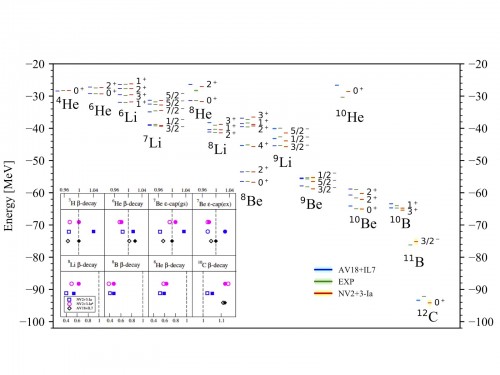The research activity in this area deals, in broad terms, with the fundamental issue of understanding the structure and dynamics of nuclei in terms of the many-body (primarily, two- and three-body) strong forces governing the interactions among their constituents, i.e., the nucleons, and the response of nuclei to electromagnetic and weak probes in terms of the coupling of these probes to individual nucleons and to many-body clusters of nucleons. We refer to such a theoretical framework as the “basic model.’’
The emergence, over the last three decades or so, of chiral effective field theory (chiral EFT) has led to a new phase in the evolution of the basic model, and to renewed interest in its further development. In chiral EFT, the symmetries of QCD, in particular its approximate chiral symmetry, are exploited to systematically constrain classes of Lagrangians describing, at low energies, the interactions of baryons (nucleons and Δ resonances) with pions as well as the interactions of these hadrons with electroweak fields. Indeed, a significant part of the research effort in this area has been directed, over the last several years, to the formal development of two- and three-nucleon interactions and nuclear electroweak currents within chiral EFT.
When coupled to numerically accurate quantum Monte Carlo or variational hyperspherical harmonics expansion methods, the deceptively simple picture put forward in the basic model has been shown to provide a quantitatively successful description of properties and reactions of light nuclei over a broad energy range, from the keVs relevant in nuclear astrophysical contexts, to the several MeVs of nuclear spectra and radiative and weak decay processes, to the GeV regime probing the short-range structure of nuclei and the limits of the basic model itself, both of which are currently being investigated experimentally at Jefferson Lab.

In the low-energy regime, specific recent examples are the studies, in light nuclei, of energy spectra based on chiral two- and three-nucleon interactions, and of beta decays and electron capture processes with nuclear weak currents derived from chiral EFT. At intermediate energies, a recent example is the fully ab initio quantum Monte Carlo study of the neutrino flux-folded inclusive cross sections measured on the carbon nucleus by the MiniBooNE and T2K collaborations in the charged-current quasielastic regime: the calculated cross sections are in good agreement with the MiniBooNE and T2K data. These results, when combined with those relating to low-energy radiative and weak transitions mentioned above, yield a consistent picture of nuclei and their electroweak properties across a wide regime of energy and momentum transfers.

